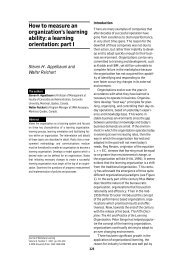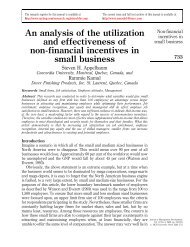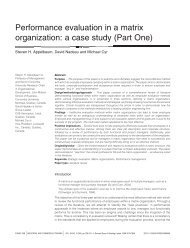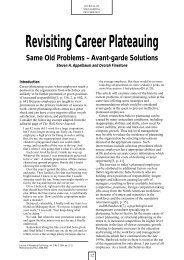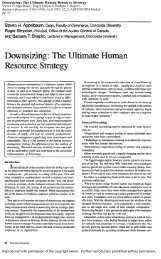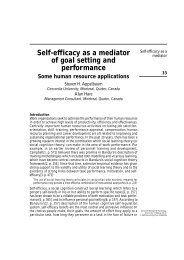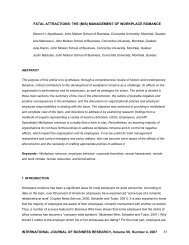Back to the future: revisiting Kotter's - Dr. Steven H. Appelbaum ...
Back to the future: revisiting Kotter's - Dr. Steven H. Appelbaum ...
Back to the future: revisiting Kotter's - Dr. Steven H. Appelbaum ...
You also want an ePaper? Increase the reach of your titles
YUMPU automatically turns print PDFs into web optimized ePapers that Google loves.
JMD<br />
31,8<br />
770<br />
appears <strong>to</strong> be as significant in 2011 as it was in 1996 and even more so per some case<br />
studies presented.<br />
Step 4: communicate <strong>the</strong> change vision<br />
Communication is a critical element of <strong>the</strong> organizational change process as it can<br />
reduce uncertainty (Bordia et al., 2004), decrease ambiguity and can even affect <strong>the</strong><br />
type of positive or negative responses <strong>to</strong> organizational change (Nelissen and van<br />
Selm, 2008). Uncertainty is defined by Salem and Williams (1984), as an inability <strong>to</strong><br />
describe, predict, or explain. Complaints of inadequate information are common in<br />
organizations (Daniels and Spiker, 1983). A study conducted by Nelissen and van Selm,<br />
(2008) served <strong>to</strong> explore <strong>the</strong> correlation between responses of survivors of an<br />
organizational restructuring and downsizing and <strong>the</strong> role of management<br />
communication. Their studies found that <strong>the</strong> most significant correlations were<br />
between employee satisfaction and management communication. It was determined<br />
that employees who are satisfied with <strong>the</strong> management communication saw more<br />
personal opportunities and had a positive state of mind on <strong>the</strong> organizational change,<br />
lending support <strong>to</strong> Kotter’s fourth step (Nelissen and van Selm, 2008). Fur<strong>the</strong>rmore,<br />
<strong>the</strong>se employees felt confident in <strong>the</strong> successful enrolment of <strong>the</strong> change (Nelissen and<br />
van Selm, 2008). Employees who felt <strong>the</strong> survival of <strong>the</strong> company depends on <strong>the</strong><br />
organizational change showed positive responses regarding <strong>the</strong> high quality of<br />
management communication (Nelissen and van Selm, 2008).<br />
Ano<strong>the</strong>r study conducted by Frahm and Brown (2007) investigated whe<strong>the</strong>r<br />
communication during organizational change was linked <strong>to</strong> employees’ receptivity <strong>to</strong><br />
change. The researchers found that weekly team meetings allowed employees <strong>to</strong> be<br />
trusting and open (Frahm and Brown, 2007). They were able <strong>to</strong> discuss <strong>the</strong> changes<br />
as well as <strong>the</strong>ir subsequent implications with <strong>the</strong> manager. The study results showed<br />
that frustrated employees typically felt this way due <strong>to</strong> a lack of involvement in <strong>the</strong><br />
change process and due <strong>to</strong> a lack of information regarding <strong>the</strong> changes. However, much<br />
like <strong>the</strong> Nelissen and van Selm, (2008) study, <strong>the</strong>re were sub-groups of employees who<br />
had a positive outlook about <strong>the</strong> changes. Such employees viewed <strong>the</strong> necessary<br />
changes as an “opportunity for personal gain” and perceived change as “a welcome<br />
response <strong>to</strong> perceived organizational problems carried over from <strong>the</strong> past”. It was<br />
determined that <strong>the</strong>se were also participants who were more involved in <strong>the</strong> change<br />
process compared <strong>to</strong> o<strong>the</strong>rs. Therefore, like <strong>the</strong> participants in <strong>the</strong> Smith et al. (1995)<br />
research, employees with a higher level of participation and greater dialogue<br />
responded more positively <strong>to</strong> change.<br />
Klein (1996) suggests a number of effective communication strategies based on<br />
empirical principles found in <strong>the</strong> literature in order <strong>to</strong> apply <strong>the</strong>m <strong>to</strong> various stages of<br />
organizational change. These strategies, as listed, strongly support Kotter’s overall<br />
communication requirement:<br />
.<br />
People’s memory can be increased by diffusion and repetition of <strong>the</strong> message<br />
through several media, leading <strong>to</strong> message retention (Bachrach and Aiken, 1977;<br />
Daft and Lengel, 1984; Dansereau and Markham, 1987). This point supports<br />
Kotter’s suggestion <strong>to</strong> ensure that <strong>the</strong> change message and vision is repeatable<br />
as “ideas sink in deeply only after <strong>the</strong>y have been heard many times” (Kotter,<br />
1996, p. 90).<br />
.<br />
Kotter maintains that “two-way communication is always more powerful than<br />
one-way communication” (Kotter, 1996, p. 90). This is confirmed by D’Aprix



